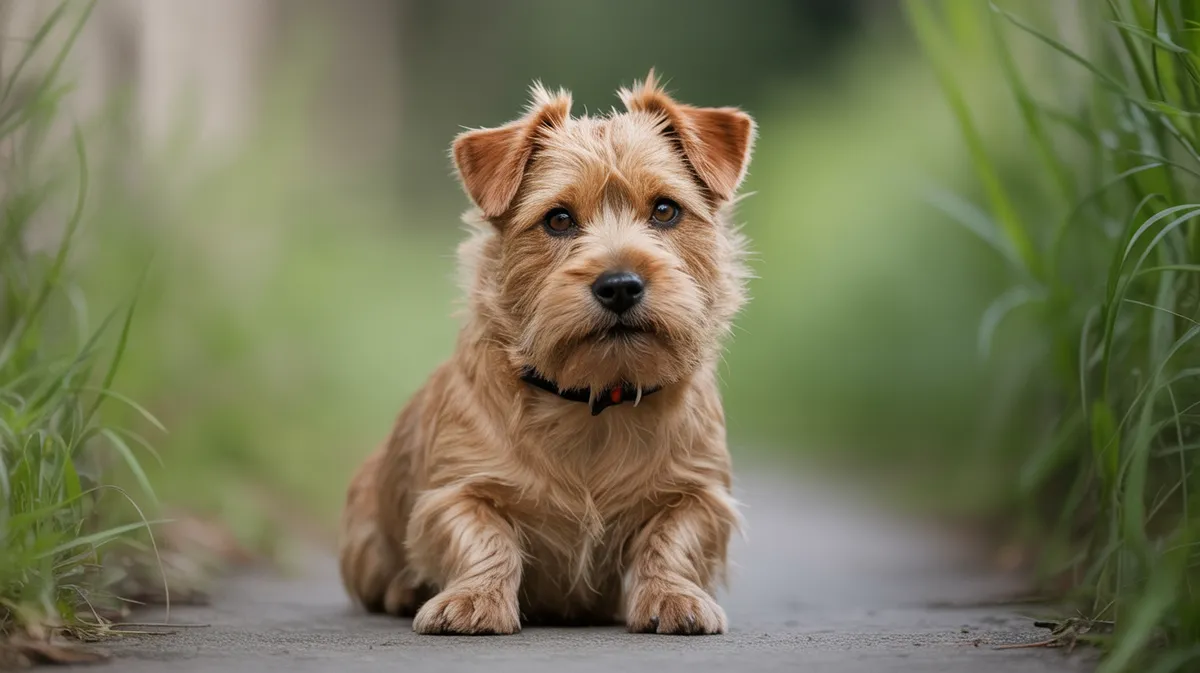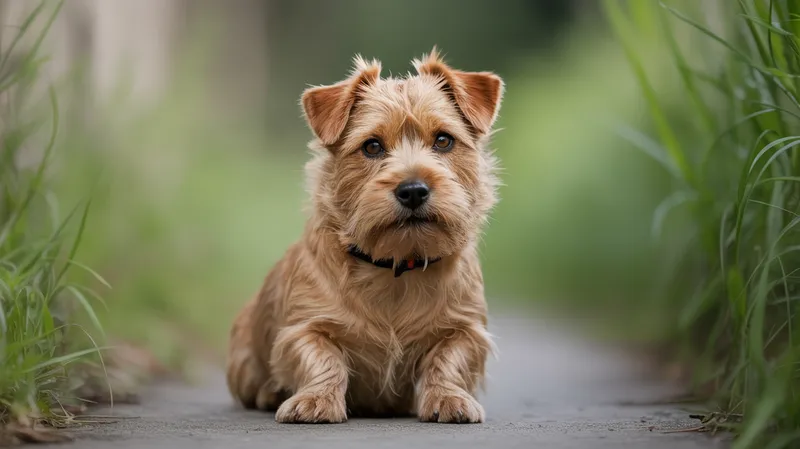
Norfolk Terrier
Canis lupus familiaris

Meet the Norfolk Terrier
The Norfolk Terrier is one of the smallest working terriers, originally bred in England for hunting vermin and small rodents. Known for its spirited, affectionate, and fearless temperament, this breed is characterized by its wiry, weather-resistant coat and distinctive folded (drop) ears. Norfolk Terriers are energetic and intelligent dogs that adapt well to both rural and urban environments, making them excellent companions. Their friendly nature and compact size make them suitable for families, but they retain a strong prey drive and require regular exercise.
Classification
Mammal
Habitat
Domestic, often in homes and urban or suburban settings
Diet
Omnivore
Lifespan
12–16 years
Conservation
Least Concern
Weight
5–6 kg (11–13 lbs)
📖Fascinating Facts
Compact Hunter
Norfolk Terriers were originally bred for hunting vermin and have excellent instincts, making them tenacious little hunters.
Distinctive Ears
Unlike the Norwich Terrier, Norfolk Terriers have unique drop ears that fold forward, giving them a softer expression.
Adaptable Companions
These dogs adjust well to apartment life or the countryside, provided they get daily exercise and mental stimulation.
📋Detailed Description
The Norfolk Terrier is a compact, sturdy, and low-set breed, typically standing 25 to 30 cm (9.8 to 11.8 in) at the shoulder and weighing between 5 to 7 kg (11 to 15 lbs). Its body is slightly longer than tall, with a level topline and well-sprung ribs, giving it a robust and agile appearance. The breed's hallmark is its drop (folded) ears, distinguishing it from the prick-eared Norwich Terrier. Norfolk Terriers possess a hard, wiry, and straight double coat, which is weather-resistant and provides protection during outdoor activities. Their expressive, oval-shaped dark eyes convey alertness and intelligence. The tail is customarily left natural, carried gaily but not curled over the back. Anatomically, they have strong jaws and a scissor bite, reflecting their origins as vermin hunters. Their compact size belies their remarkable stamina and agility, traits essential for working in dense undergrowth or confined spaces. The breed is known for its affectionate, spirited, and fearless temperament, making it both a capable working dog and a devoted companion.
💡 Did you know?
Norfolk Terriers are one of the only terrier breeds with naturally folded ears, setting them apart from many other small terriers.
🔬Research & Sources
Wikipedia Summary
The Norfolk Terrier is a British breed of dog. Prior to gaining recognition as an independent breed in 1964, it was a variety of the Norwich Terrier, distinguished from the "prick eared" Norwich by its "drop ears". Together, the Norfolk and Norwich Terriers are the smallest of the working terriers.
Last Modified: 10/19/2024
🎭Behavior & Social Structure
Norfolk Terriers are highly energetic and inquisitive, displaying pronounced terrier instincts such as digging, chasing, and alert barking. Historically bred for hunting vermin, they retain a strong prey drive and will actively pursue small animals if given the opportunity. They are intelligent and quick learners, responding well to positive reinforcement but can be independent-minded, requiring consistent training. Socially, Norfolks are generally friendly with people and other dogs, though early socialization is important to prevent excessive timidity or assertiveness. They thrive on human companionship and may develop separation anxiety if left alone for extended periods. Daily routines should include ample physical exercise and mental stimulation, such as interactive play or scent-based games. Their alertness and vocal tendencies make them effective watchdogs, though they are not typically aggressive.
👶Reproduction & Life Cycle
Norfolk Terriers reach sexual maturity between 8 to 12 months of age, though responsible breeding is generally recommended after 18 months. The breed exhibits no marked seasonality in estrus, as is typical for domestic dogs. The female's gestation period averages 63 days. Litter sizes typically range from 2 to 5 puppies. Parental care is primarily provided by the dam, who nurses and grooms the puppies for the first three to four weeks. Puppies are weaned by 6 to 8 weeks and should remain with the mother and littermates until at least 8 weeks of age for optimal social development. Responsible breeders screen for hereditary conditions, such as mitral valve disease and hip dysplasia, to ensure healthy offspring.
🛡️Adaptations & Survival
The Norfolk Terrier's wiry, weather-resistant coat is a key adaptation, allowing it to work in harsh climates and dense vegetation without injury. Its compact, muscular build and relatively short legs enable it to maneuver through tight spaces, such as burrows or undergrowth, while pursuing prey. The breed's acute sense of smell and hearing are highly developed, facilitating efficient detection of rodents and other small animals. Behaviorally, their boldness and persistence are evolutionary traits selected for effective vermin control. Their sociable disposition and adaptability to various living environments reflect domestication and selective breeding for companionship as well as utility.
📚Research Sources
🎨Cultural Significance
The Norfolk Terrier has a notable place in British canine culture, valued both as a working terrier and a companion animal. Its origins trace back to the late 19th and early 20th centuries in East Anglia, where it was prized for its effectiveness in controlling vermin on farms and in stables. The breed was officially recognized as distinct from the Norwich Terrier in 1964, largely due to its unique ear carriage. Today, Norfolk Terriers are celebrated in dog shows and are popular among urban and rural families alike. They symbolize tenacity, loyalty, and adaptability in British dog breeding traditions.
🔬Recent Research & Discoveries
Recent genetic studies have explored the relationship between the Norfolk and Norwich Terriers, confirming their close ancestry and the genetic basis for ear carriage differences. Ongoing research in veterinary medicine focuses on breed-specific health concerns, particularly cardiac and orthopedic conditions. Behavioral studies highlight the breed's intelligence, adaptability, and suitability for various canine sports, including agility and earthdog trials. Advances in canine genomics are aiding breeders in reducing the incidence of inherited diseases through DNA testing and selective breeding programs.
🎥Wildlife Videos

Exploring the Fascinating World of Norfolk Terrier | Interesting Facts | The Beast World
Exploring the Fascinating World of Norfolk Terrier| Interesting Facts | The Beast World Here are some fascinating facts about the ...
The Beast World

a short Border Terriër movie (dogs on adventure!)
Are you a dog and nature lover? Then this beautiful short film is worth watching! Great nature footage and beautiful adventures of ...
Herwin Kwint

3 Hours of The Untold Stories of British Wildlife | Our World
A wildlife documentary series, narrated by Hugh Bonneville, uncovering the hidden lives of animals across diverse habitats ...
Our World

A short Border Terriër movie (Dogs and Beautiful Nature)
Puppy Mannes meets Granpa Otter,. Grandpa teaches his student all kinds of things, but the puppy doesn't really want to listen ...
Herwin Kwint

Norfolk Terrier - AKC Dog Breed Series
Learn more about Norfolk Terrier http://www.akc.org/dog-breeds/norfolk-terrier/
American Kennel Club

Norfolk Terrier climbs tree!
Grand Champ Poppy is the Versatility Queen and loves to go ip the tree after the squirrel.
Donna West - A Glimpse In-between
🌍Habitat Information
The Norfolk Terrier typically inhabits Domestic, often in homes and urban or suburban settings environments. Norfolk Terriers have adapted to their environments with specialized features and behaviors.
Primary Habitat:
Domestic, often in homes and urban or suburban settings
More detailed habitat information will be available soon.
🛡️Conservation Status
The Norfolk Terrier is currently classified as Least Concern. Conservation efforts are crucial for preserving this species for future generations.
Common Threats:
- 🏠Habitat loss and fragmentation
- 🌡️Climate change impacts
- 🎯Hunting and poaching
- 🏭Human-wildlife conflict
⚠️Threats & Conservation Challenges
As a domesticated breed, the Norfolk Terrier does not face threats in the wild; however, it is susceptible to challenges common to purebred dogs. These include genetic health issues such as mitral valve disease, hip dysplasia, and certain eye disorders. Overbreeding and irresponsible breeding practices can exacerbate these problems. The breed remains relatively rare, and maintaining genetic diversity is a concern among breeders. Human impact is largely positive, as the breed is maintained through dedicated breed clubs and enthusiasts. There are no significant population declines, and the breed is classified as 'Least Concern' in terms of conservation.
🔬Scientific Classification
Scientific Name
Canis lupus familiaris
Classification Hierarchy
🔍 About Taxonomic Classification
Taxonomic classification is a hierarchical system used by scientists to classify and organize living organisms based on shared characteristics and evolutionary relationships.
The system moves from broad categories (Kingdom) to increasingly specific ones, with each animal's scientific name typically consisting of its Genus and species.
📝Community Notes
Share your observations and insights about the Norfolk Terrier with our community of wildlife enthusiasts.
Join Our Community
Sign in to share your observations and connect with fellow wildlife enthusiasts.
Sign In to ContributeNo community notes yet
Be the first to share your observations about the Norfolk Terrier!
Explore Norfolk Terrier
Select a tab above to learn more about this amazing animal.
📸Photo Gallery
No photos available for this animal yet.
🌟Discover More Wildlife
Continue your journey of discovery with more fascinating animals from our database
